![]()
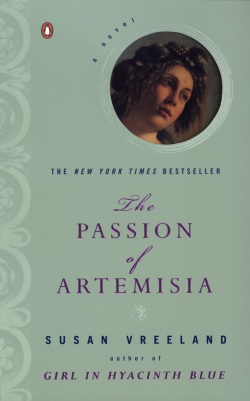

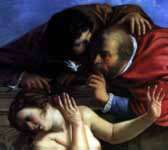

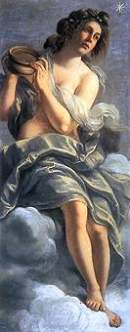

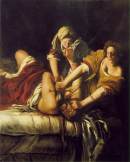

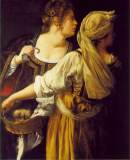

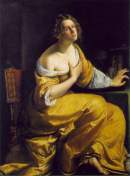



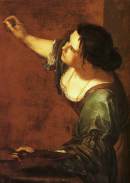



Teacher's Guide for
The Passion of Artemisia
This page contains:
Suggested Scenes for Reading Aloud
Topics for Class Discussion
Collaborative Research Topics
Topics for Personal Inquiry
A Creative Project
In-class Writing Prompts
Essay Topics
Background Information
Bibliography of Useful Sources
Teachers are encouraged to download material useful for educational purposes, and to send any topics or projects they devise to Susan Vreeland for posting here.
The Image Gallery of Artemisia's paintings on the website features those works which appear in the novel.
Because emphasis is often placed on having students relate a piece of literature to themselves,
to the world as they know it, and to other pieces of literature, topics and activities that
fulfill these functions are marked as follows:
T-S -- Text to Self
T-W -- Text to the World
T-T -- Text to Text
Suggested Scenes for Reading Aloud:
1. The opening court scene of Agostino's trial and Artemisia's torture, p. 1-7.
2. Sister Graziela's revelation of her life before the convent and her advice to Artemisia, p. 36-40.
3. Artemisia's presentation of her paintings to the Accademia dell' Arte in Florence, p. 62-64.
4. Artemisia and Pietro's romantic scene in Giotto's bell tower in Florence, p. 158-162.
5. Artemisia's scene challenging Pietro to accompany her to Genoa, and their breakup, p.167-170.
6. Artemisia and Palmira's argument while mother is teaching painting to her daughter, p. 251-3. (This is particularly appropriate for a two-person dramatic reading.)
7. Artemisia's letter to Galileo, p. 227-228.
8. The last argument between Artemisia and her father, p. 274-6, and the reconciliation, p. 281-285, also suitable for a two-person dramatic reading.
Topics for Class Discussion:
Please note that some of these are suitable for student compositions, as well as for discussion in pairs or small groups. Underlined words are from Bloom's Taxonomy of thinking skills. See footnote.
1. Given Agostino's rape of Artemisia, identify what choices of action she had. Assess whether her decisions were the best ones she could have made in seventeenth century Italy. (T-W) What, if anything, might she have done to prevent the rape?
2. Orazio is seen by Artemisia as the originating cause of her misfortunes. To what degree is this a fair assessment? Defend Orazio's actions in the context of gender and parental roles in seventeenth century Italy. (T-W) How might the attitudes of the time have influenced him? (T-W) Did he love her?
3. Speculate as to the reason for Artemisia's torture when it was Agostino who was on trial.
4. Why might Artemisia have chosen to paint Susanna and the Elders in 19ll? How did the painting reflect her sensibilities and experience at that time? See the Image Gallery on the website.
5. Sometimes, it's too easy to assume that in centuries past, women were victims of gender prejudice and limitations. What misfortunes in Artemisia's experience were caused by her own thinking and actions? What better decisions could she have made? What advantages did Artemisia have as a woman?
6. To what extent was Sister Graziela in control of her own fate?
7. When Graziela gives Artemisia the pearl earring, she also gives her some advice. Tell how Artemisia followed and did not follow this advice. When it's her turn to give advice to Palmira, she compresses it to one line. Assess the value of that advice, and explain why it was so important to her.
8. Make a judgment about the relationship between Artemisia and Pietro. What good and/or poor decisions did Artemisia make regarding him?
9. Judge whether Artemisia was a good mother. Explain why or why not.
10. In what ways did Galileo influence Artemisia? What did they appreciate in each other? Quote textual references.
11. In what ways does the term passion apply to Artemisia, Orazio, Galileo, and Graziela? Do some dictionary study to discover the religious meanings of this word. How is Michelangelo's Pieté echoed by the characters?
12. Analyze the relationship between Orazio and Artemisia. Identify at least three occasions of betrayal by Orazio of Artemisia. Compare Artemisia and Orazio. What similarities do you find between them in terms of their values and motivations?
13. Compare Artemisia's paintings with Orazio's of the same subjects. Draw some conclusions based on their choice of moments to portray, the faces and postures of the figures, the coloration.
14. Artemisia told Palmira, "To be a painter, you've got to care for people, for their feelings." Why did she believe this? Is it true for all art in all time periods? (T-W)
15. Examine how Artemisia influenced the minor female characters--Umiliana, Fina, Vanna, Renata, and Paola. What did she learn from them? How are they representatives of the seventeenth century, or exceptions to the social mores of the time? (T-W)
16. Through what stages must Artemisia grow if she is to reconcile with her father? What experiences and recognitions move her in that direction, or away from that direction?
17. In what sense was Artemisia religious? What applications in her life do you see of the Magnificat that the nuns sang; the dictum Optimam Partem Elegit, "Choose the better way," which Artemisia wrote on the chair of Mary Magdalene; or the religious art surrounding her in Rome and Florence? What did Artemisia learn from Paola?
18. Speculate what Artemisia, the woman with the same history and sensibilities, would be painting if she lived in the nineteenth century. What would her style(s) be like? What might her style and subjects be if she lived now?
19. Speculate which artists Artemisia might have admired if she could have seen the developments in art history after her as well as before. Defend your choices by reference to specific works by Artemisia and others and by things she said in the novel.
20. Artemisia asked her father, "Haven't you ever felt like shouting, 'Look. Look and let this beauty transform your heart'?" Has this happened to her? What beauties? What transformation?
Collaborative Research Projects:
Most of these topics involve some research into art history, social history, or Biblical narratives. They can be addressed by students in pairs or larger groups, and results of the research can be presented to the class, or prepared in written form.
1. Artemisia frequently painted Biblical themes. Research in the library or on line the histories accompanying the Biblical figures of Susanna, Mary Magdalene, Judith, Esther, and Bathsheba. (T-W) Mary Garrard's Artemisia Gentileschi: Image of the Female Hero in Italian Baroque Art is a good source. What individual interpretation (called invenzione by Italians) did Artemisia give to these heroines which differed from prior portrayals?
For Judith, consider portrayals by Orazio, Caravaggio, Guido Reni, Andrea Mantegna, Michelangelo, Boticelli, Giorgione, Gustav Klimt and the sculptures by Donatello and on the Chartres Cathedral.
2. Do the same research for Lucretia and Cleopatra, actual historical figures, and, by examining Artemisia's paintings, assess her particular interpretations of the figures at the moment she chose to portray them. (T-W)
3. Select one female figure Artemisia painted which you like and explain why. (T-S) Trace this figure as painted by four other artists. You might choose Judith, Cleopatra, Lucrezia, Susanna, Esther, or Mary Magdalene. Compare the interpretations and style of your figure as portrayed by the other artists.
4. Identify some paintings by Artemisia which reflect specific characteristics of the Baroque period. (See Background Information below.) (T-W) Explain what is going on in the painting at this moment.
5. Select another female artist and do a comparison of her life, her attitudes, her cultural climate, her time in history and in art history, her artistic themes, and her style to Artemisia's. (T-W)
Here are some women to consider, but there are more.
- Emily Carr, Canadian, fiercely independent and eccentric early twentieth century modernist who painted British Columbia forest, native villages, and totem poles, and who sought spirituality in nature (see Vreeland's The Forest Lover)
- Georgia O'Keeffe, American, takes up natural themes in the Southwest; labeled by critics as a shameless nymphomaniac
- Frida Kahlo, Mexican, wife of Diego Rivera, yes the same person as in the recent movie, Frida; horrible life-long suffering--look at any of her paintings and you'll see it
- Mary Cassatt, American Impressionist, considered oh-so-feminine; painted themes of motherhood
- Berthe Morisot, French Impressionist, central to Impressionist movement--was she in love with Degas?
- Judith Leyster, Dutch Renaissance painter who eclipsed her famous teacher but died an unknown
- Suzanne Valadon, self-taught French Modernist, bohemian and rebel
- Hildegard von Bingen, German medieval illuminator of manuscripts, nun, and advisor to monarchs
- Angelica Hauffmann, 18th century Swiss who played hardball with the big boys
- Elisabeth Vigée-Le Brun, court painter to Marie Antoinette, a dangerous liaison
- Camille Claudel, French; lover, model, and student of Rodin; sex, lies, sculpture, madness, tragedy, and despair
- Käthe Kollwitz, German, caught in Nazi political crossfire; felt all art is political
You might find The Guerrilla Girls Bedside Companion to the History of Western Art, to be enlightening as well as an amusing, wisecracking romp. Author: The Guerrilla Girls, (they are unknown, which is to say, they keep their identities secret). Publisher: Penguin, 1998 [ISBN: 0-14-02.5997x]. They ask: Why haven't more women been considered great artists throughout Western history? Why do we always have to be called "women artists"? They don't call Rembrandt and van Gogh "male artists." Why does being African American and female make it twice as hard for one's work to be remembered? Beware: the Guerrilla Girls make trouble!
6. Rape has been a frequent motif in Italian art. Speculate as to why you think this is.
Locate images in the library or online of the following pieces of art, and research the myths,
narratives, and history that accompanies them. Start with:
Rape of a Sabine, sculpture by Giovanni da Bologna
Rape of Dejanara, painting by Guido Reni
Apollo and Daphne, sculpture by Gianlorenzo Bernini
Pluto and Proserpina, sculpture by Gianlorenzo Bernini
Rape of the Sabines, painting by Nicholas Poussin
Rape of Europa, paintings by Titian and Veronese
Rape of Danae, paintings by Artemisia and Titian
Primavera, Botticelli
Draw some conclusions and present to the class. (T-W)
(A good reference is Images of Rape: The 'Heroic' Tradition and its Alternatives, by Diane Wolfthal, in which she states, "It is not surprising that artists in the fifteenth to the seventeenth centuries portrayed rape as heroic or that art historians regard such portrayals more highly than others. Canonized works--'produced by men for men'--served to teach lessons about the proper place of women in marriage or to provide erotic stimulation for men." Although Artemisia had to function in institutional contexts that were dominated by male expectation, she never painted a scene showing an act of abduction or ravishment in process.)
Topics of Personal Inquiry:
Of all her paintings, identify one (or more than one) which speak to you most strongly. (T-S) Do one or several of the following:
1. Write a description of it/them providing the reasons it/they appeal(s) to you. (T-S)
2. Write a hypothetical letter to the figure in your selected painting, bringing the figure up to date about a topic you think he/she would be interested in. (T-W)
3. Write a letter from this person to a close friend of this person. Have it concern the moment portrayed, as well as reveal something about the recipient. Rewrite the letter to reveal something of yourself, as though you in a different time period were the person receiving the letter.
A Creative Project:
Use a painting by Artemisia to spark a poem. Start by slowly surveying the paintings in the Image Gallery of www.svreeland.com. You might narrate the meaning of a scene the way Artemisia imagined it, write it from the point of view of the figure in the painting, or just respond from your own well of experience to the shapes, colors, setting, and the feel of the subject. (T-S, considering the painting as a text) You might choose to address one of the questions below, but don't feel you need to write a direct answer to the question in your poem. Just let one of the following questions (or one you pose, T-S) together with an image suggest a line of thinking, and follow it.
What considerations were swirling around in Susanna's mind when threatened by the two men?
What motivated Judith to slay Holofernes?
Why did Abra, Judith's maid, accompany her to the enemy tent to slay Holofernes? Was it loyalty? fear? anger?
Was Mary Magdalene anticipating her new life positively, regretting her old life, or fearing the afterlife?
What if you were Cleopatra, defeated and facing jeering crowds in Rome. Would you have killed yourself? What other realistic options would you consider, given the circumstances?
What is in Lucretia's mind at the moment she grasps the dagger?
If you were to paint a self-portrait, how would you portray yourself? With what qualities? Doing what act? Dressed in what colors? Associated with what historical time period? (T-S)
In-class Writing Prompts:
Write a definition of the human heart. Teachers: Have students volunteer to read theirs aloud. Draw a conclusion about how the class (or each group within the class) thinks. Have the students turn to page 252 and compare their definitions to Artemisia's. Ask them: Who comes closest to agreement with her? What other student's definition, different than Artemisia's, do you like?
Write a statement about what great art is supposed to do. Teachers: Read them aloud, or ask for volunteers to read. Have them draw a conclusion about how the class (or each group within the class) thinks. Have the students turn to page 266 and compare their statements to Artemisia's. Ask: Who comes closest to agreement with her?
Essay Topics:
1. Identify three aspects of seventeenth century Italy that the novel illuminated. Cite textual sources for each, and explain how they impacted women's lives in general, and Artemisia's life in particular. Consider the other female characters in your assessment.
2. Inquiring into what state of mind is most beneficial for creative work, Virginia Woolf says in A Room of One's Own that, "the mind of an artist, in order to achieve the prodigious effort of freeing whole and entire the work that is in him, must be incandescent, like Shakespeare's mind...All desire to protest, to preach, to proclaim an injury, to pay off a score, to make the world the witness of some hardship or grievance was fired out of him and consumed. Therefore his poetry flows from him free and unimpeded. " Apply this to Artemisia--her life and work. (T-T) Should a woman who had Artemisia's reasons for grievance be expected to act out Woolf's principle? To what degree was it necessary to set it aside to give birth, whole and unstained, to the work she was capable of doing? Or, could the circumstances of her life serve a creative purpose? What would be required of a woman in seventeenth century Italy to keep that mind incandescent? (T-W)
3. How did Vreeland translate the characteristics of Baroque art (see Background Information, below) to the narrative? Consider her prose style; the scenes she chose to include; the minor characters and their conflicts, limitations, and lives.
4. Write an analysis (a close textual study) of Artemisia's letter to Galileo on page 227, examining Galileo's influence on her thinking, their relationship, and the underlying currents of her thinking, the unstated issues that are worrying her, and the overall tone of the letter.
5. Select a phrase or sentence from a scene and analyze how it applies to the whole novel. Suggested lines:
- "We, you and I, are in the business of painting truth. Let them find beauty in that." p. 247
- "To be a painter, you've got to care for people, for their feelings." p. 252
- "An artist's feeling is the white-hot core of painting."
- "You've got to use your own emotions and paint with your own blood if need be in order to discover and prove the truth of your vision." p. 252-3
- "If a person loves something above all else, if he values the work of his heart and hands, then he should naturally, without hesitation, pour into it his whole soul, undivided and pure. Great art demands nothing less." p. 103
- "That's what great art is supposed to do--help us to live in the spirit and die at peace." p. 266
- "What is a heart but the working of the imagination in behalf of the other person?" p. 252
- "You've got to want it enough that the thought of it being taken from you would make you a little crazy." p. 253
- "In an easy life, the imagination doesn't grow." p. 254
- "It's better to have a hunger and appreciation for beauty than to be merely beautiful. In the end, life is richer that way." p. 271
- "Haven't you ever felt like shouting, 'Look. Look and let this beauty transform your heart'?" p. 281
- "The highest of arts is to uplift the spirit, whatever means one uses." p. 148
- "Remember the Magnificat? 'My soul doth magnify the Lord.' That's what you've done--made the Lord's beauty larger with your life's work." p. 283
Background Information:
Baroque Art
The Baroque Period refers to the post-Renaissance art of the seventeenth century. Baroque was a term used by scholars after the time period was over. The Portuguese word for an irregular pearl, perla barocca, suggested exotic, dramatic, irregular beauty. Baroque art was a reaction to the stiff formality, ideal beauty, balance and symmetry of the Renaissance. Characteristics of the Baroque include:
- Dynamic, dramatic, eccentric, unbalanced or asymmetric, exuberant, sinuous, irregular shapes and composition
- Emotional moments of bigger than life figures from myth, legend, religious and secular history
- Figures twisted, torqued, reeling, frozen in action, in medias res
- Figures leaping into viewers' laps, placed forward in the picture frame to give a sense of procimity and immediacy
- Drama achieved through a strong light source, and tenebroso, the sharp contrast of light and dark, as used by Caravaggio
- Portrayal of realistic individuals, models taken off the street, not idealized stereotypes of perfect proportions
Women Artists
Germaine Greer's groundbreaking book, The Obstacle Race: Fortunes of Women Painters and their Work, indicates the reasons there were so few female artists in the Middle Ages through the eighteenth century. She cites the following obstacles to women becoming painters: exclusion from academies, difficulty of getting training in apprenticeship programs; the required time demanded by family obligations and motherhood; the distraction of love; the undervaluing of the paintings by women resulting in misattributions to their painting teachers or to artists contemporary to them; the negligence of musems and patrons collecting works by women; frequent disappearance and even destruction of works by women.
Artemisia's Art
Living from 1593 to 1653, Artemisia Gentileschi began to paint full scale works in her early teens. Her oeuvre consists of 53 firmly identified paintings, 42 additional paintings of questionable attribution, and 108 paintings identified as possibly by Artemisia but lost to history. What cannot be disputed is that she produced works of startling invention expressing a feminist sensibility in strong heroines caught in moments of danger or tension, thinking or acting against convention. She was the first woman to be admitted to the Accademia dell' Arte del Disegno in Florence, as well as the first woman to make her independent living solely by her brush, either one a significant achievement in her time.
Marriage
In seventeenth century Italy, marriages were arranged by the parents, often through an intermediary. Little choice, if any, was permitted the daughter. Sexual liberties were allowed prior to marriage if the bans had been posted. If the results were not to the man's liking, he could call off the marriage. If a woman was raped, the way to mend her damaged reputation was to marry the rapist; the result of this practice was, in effect, marriage by conquest, though it was called nozze di reparazione (marriage of repair or remedy).
Galileo
Galileo was indeed a friend of Artemisia. He was the court mathematician for Cosimo Medici the Second. There exists a letter from Artemisia to Galileo calling upon his friendship to intercede in her behalf with Cosimo to urge him to pay what he owed her. Also, there is a theatrical program listing as part of the dramatis personnae both "the court mathematician" and "a famous Florentine painter--a woman."
Bibliography of Useful Sources:
- Bissell, R. Ward. Artemisia Gentileschi and the Authority of Art: Critical Reading and Catalogue Raisonné. Pennsylvania University Press, 1999.
- Christiansen, Keith and Judith Mann. Orazio and Artemisia Gentileschi. Metropolitan Museum of Art, and Yale University Press, 2001.
- Gardner's Art Through the Ages, Harcourt Brace.
- Garrard, Mary. Artemisia Gentileschi: The Image of the Female Hero in Italian Baroque Art. Princeton University Press, 1989. The seminal work on Artemisia which supplies comparisons of her paintings with those of the same subjects by other painters.
- Garrard, Mary. Artemisia Gentileschi Around 1622: The Shaping and Reshaping of Artistic Identity. University of California Press, 2001.
- Greer, Germaine. The Obstacle Race: The Fortunes of Women Painters and Their Work. Farrar, Straus, & Giroux, 1979.
- Lapierre, Alexandra. Artemisia. Grove Press, 1998.
- O'Neill, Mary. "Artemisia's Moment," in Smithsonian, vol 33, no. 4, May 2002, pp 52-58.
- Sobel, Dava. Galileo's Daughter. Walker & Co., 1999. Gives insight into convent life during this time as well as Galileo's encounters with the Inquisition.
- Crawford, Sidnie White, "Esther, not Judith: Why One Made It and the Other Didn't," BR (Bible Review), Vol 18, no. 1, February 2002, p. 22+. Gives history of Judith in art and the church.
* Since Bloom's Taxonomy ranking thinking skills often informs curriculum, those directives of the taxonomy used in this guide are underlined. Skills from the following categories are involved in the question cues and activities:
Level 1: Knowledge (recall of information): tell, list, define, describe, identify, show, examine, quote, name
Level 2: Comprehension (understanding meanings): summarize, describe, interpret, contrast, predict, speculate, associate, distinguish, extend
Level 3: Application (using what has been learned): apply, demonstrate, illustrate, examine, relate, discover
Level 4: Analysis (recognition of nuances of meaning): analyze, explain, compare, select, interpret
Level 5: Synthesis (draw conclusions and create new ideas): design, create, invent, what if?, compose, formulate
Level 6: Evaluation (assessing value and making choices): make choices, assess, support, defend, convince, conclude, compare, judge